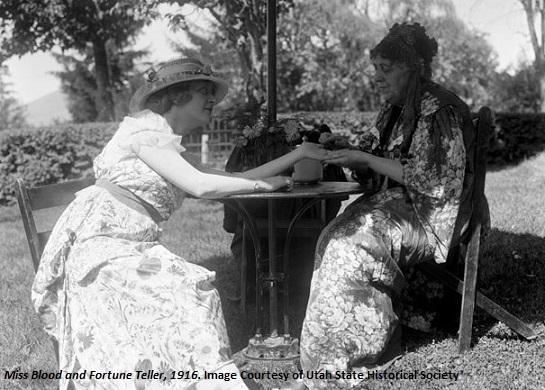Dublin Core
Title
Description
Traveling gypsies brought excitement to small towns all over Utah in the early 1900s.
To most residents of rural Utah in the early 1900s, summertime meant hauling hay, digging ditches, irrigating crops, and tending livestock. Other than the usual town parties, there was little diversion from the monotony of farm labor. That is, not until traveling groups of gypsies showed up – and stirred up excitement – in small communities all over Utah.
From Garland to Kanab, and towns in between, news of these exotic visitors spread quickly. Most gypsies were of Balkan, and Eastern or Central European descent, and had come to the United States at the turn of the century. Their traveling lifestyle took them from town to town, leading caravans of wagons, horses, dogs, and children. They generally traveled in groups of five to ten families, camped on the outskirts of town, and stayed a few weeks before moving on.
Utah residents who remember gypsies coming to their communities reported the experience with great fondness, if not some stereotyping. Gypsy men apparently wore large hats and spangled vests, while women wore full skirts and bright scarves. Gypsies earned a living by horse trading or telling fortunes, and sometimes by begging or stealing. But most stories focus on gypsies entertaining townspeople. In Manti, for example, one resident remembered a group of gypsies that owned a dancing black bear and a monkey that sat atop an organ grinder catching nickels. In Oak City, a singer entertained residents for hours at the city hall with his extensive repertoire. In Elsinore, another man performed rope tricks in an hour-long demonstration that was a highlight of the town's Fourth of July celebration.
By the 1930s, a combination of industrialization, the automobile, and the Great Depression forced many gypsies into sedentary urban settings, which brought an end to their intensely mobile way of life.
Creator
Source
Image:Oakwood, Miss Blood and Fortune Teller. Image shows Miss Blood talking with a fortune teller on the lawn outside the Holmes Oakwood home. Shipler #17277. August 18, 1916. Image courtesy of Utah State Historical Society.
_______________
See David A. Hales, "'The Gypsies Are Coming! The Gypsies Are Coming!,'" Utah Historical Quarterly 53 (Fall 1985), pp. 367-79, accessed; W. Paul Reeve, “Traveling Gypsies Brought an Exotic Lifestyle to Rural Utah,” History Blazer, February 1995, accessed http://historytogo.utah.gov/utah_chapters/statehood_and_the_progressive_era/travelinggypsiesbroughtanexoticlifestyletoutah.html
Publisher
The Beehive Archive is a production of Utah Humanities. Find sources and the whole collection of past episodes at www.utahhumanities.org
Date
2014-06-20

